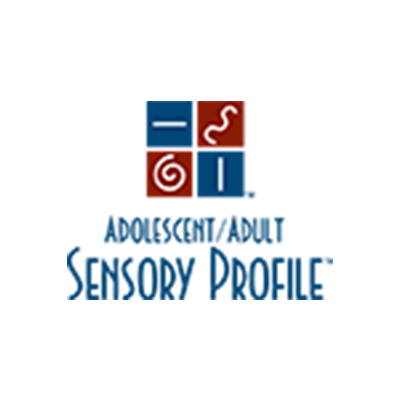Catana Brown, PhD, OTR, FAOTA, Winnie Dunn, PhD, OTR, FAOTA
Overview:Identify sensory processing patterns and effects on functional performance
Age Range:11 years and older
Completion Time:Untimed
Norms:Classification system based on normative information
Publication Date:2002
Your Scientifically-Based Choice
The Sensory Profile family of products includes the best-selling Sensory Profile, Infant/Toddler Sensory Profile, Adolescent/Adult Sensory Profile, Sensory Profile School Companion and Sensory Profile 2. The expansive age-range of Sensory Profile products allows you to confidently evaluate sensory-related difficulties in clients, from birth to geriatric.
Whatever the age of your clients — infants, child, adolescent, or adult — Sensory Profile products can help you:
- Understand the complexities of their sensory processing
- Gather critical sensory information related to home, school, and work
- Design strategies for managing daily life
These unique instruments offer a research-based, family-centered approach to sensory processing and provide case studies and guide you in interpretation and intervention planning.
Help Clients Understand and Improve Their Own Sensory Experiences
The Adolescent/Adult Sensory Profile is designed as a trait measure of sensory processing patterns and effects on functional performance. An individual answers questions regarding how he or she generally responds to sensations, as opposed to how he or she responds at any given time. This enables the instrument to capture the more stable and enduring sensory processing preferences of an individual.
A clinician can also evaluate the possible contributions of sensory processing to the client’s daily performance patterns and identify and develop client awareness and strategies to optimize the desired sensory environment.
Other Uses for Adolescent/Adult Sensory Profile
- Discover How a Parent’s Sensory Ability Can Impact a Child with Sensory Difficulties
- Evaluate parents of a child or infant with sensory processing challenges with Adolescent/Adult Sensory Profile.
- By profiling the parents for their sensory processing responses, you will gain valuable insights into the child’s interactions and help to build more family-centered intervention strategies.
See the benefits of having a parent of a child with sensory processing difficulties take the Adolescent/Adult Sensory Profile, by reading this real-world example, case study.
Features & Benefits
- Enables clients to evaluate themselves through the use of a Self-Questionnaire.
- Evaluate the possible contributions of sensory processing to the client’s daily performance patterns.
- Obtain information about everyday sensory experiences and the impact on behavior in different settings.
- Use for identifying and developing client awareness and strategies to optimize the desired sensory environment.
- Generates an individualized profile of sensory processing across four quadrants: low registration, sensation seeking, sensory sensitivity, and sensation avoiding.
- Reproducible charts provide an intervention matrix across the quadrants and six sensory processing categories
- taste/smell processing
- movement processing
- visual processing
- touch processing
- activity level
- auditory processing
- Useful in a variety of settings, school systems, mental health, vocational programs, rehab clinics, wellness centers, community based programs, and long term care facilities.
- Applicable for adolescents and adults with or without disability related issues.
- A theory-based instrument to measure sensory processing; promotes theory based decision making and intervention planning.
- Non-intrusive, easy to administer and score.
Areas of Assessment
Structure
There are 60 items on the Adolescent/Adult Sensory Profile, with 15 items for each quadrant. These quadrants cover the sensory processing categories of Taste/Smell, Movement, Visual, Touch, Activity Level, and Auditory; these categories are distributed throughout the quadrants.
Scoring and Interpretation
The quadrant scores derived from the Adolescent/Adult Sensory Profile represent patterns of sensory processing as described in Dunn’s (1997a) Model of Sensory Processing. Based on the intersection of two continua (neurological threshold and behavioral response/self-regulation), this model describes quadrants identified as Low Registration, Sensation Seeking, Sensory Sensitivity, and Sensation Avoiding. Each quadrant has its own score; it is possible for an individual to have any combination of scores. Some patterns that seem to be mutually exclusive (e.g., sensation seeking and sensation avoiding) may be present in the same individual.
Sample Reports
Reference Materials
Examining Sensory Quadrants in Autism (PDF – 141 KB)
More information (PDF – 814 KB)
Case Study
Case Study (PDF – 159 KB)
Technical Reports
Gain an understanding of the developmental aspects including sampling structure, validity, and reliability by reviewing the Technical Report (PDF – 319 KB).
Questions
Frequently asked questions follow. Click on a question to see the response.
Administration
-
When should I use the Adolescent/Adult Sensory Profile?
-
Is it appropriate to administer the Adolescent/Adult Sensory Profile on individuals with severe disabilities?
-
Why would an older adult need to be evaluated regarding sensory processing?
Scoring
-
I recently purchased the Adolescent/Adult Sensory Profile and noticed that there were no section scores; how can I determine what sensory systems contribute most to the individual’s performance differences?





